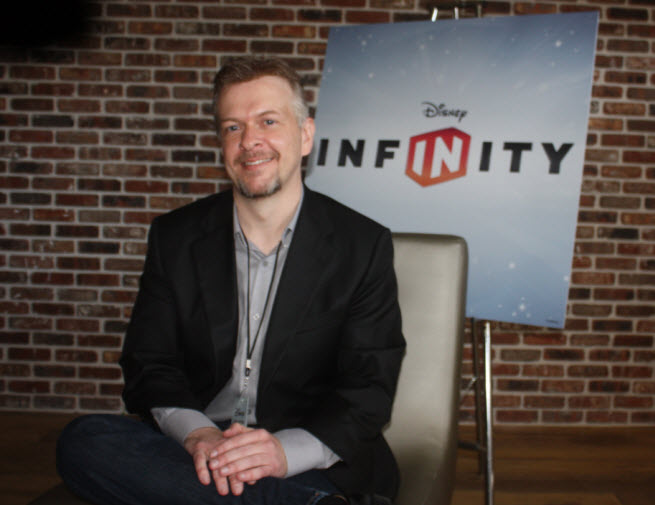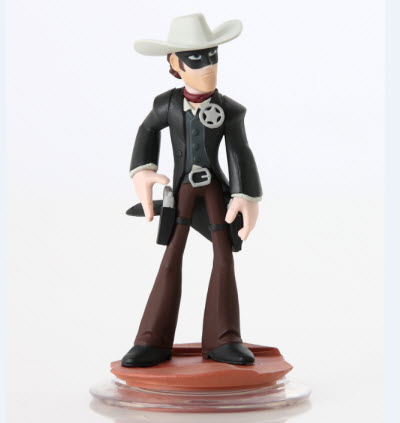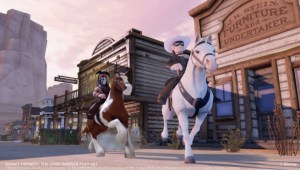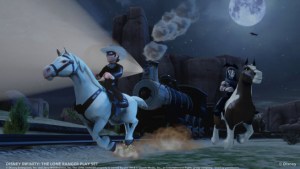Disney is about to war with Activision Blizzard in the toy-hybrid business. Out of nowhere, Activision’s Skylanders has become a $1 billion video game and toy franchise in the past couple of years. But Disney, which is no slouch in either toys or games, is about to punch back hard with the launch of Disney Infinity in August.
The title has been in development at Disney’s Avalanche Software studio in Utah for three years. And when it launches, it will effectively be five games on one platform as you can put a physical toy on it and change the entire “playset” on your console. Each playset is the equivalent of a seven-hour game built around a Disney franchise such as The Incredibles or Cars. One of the masterminds of this “transmedia” strategy — or one that spans multiple entertainment media — is John Blackburn, the co-founder of Avalanche Software and a 20-year veteran of the video game business. When Infinity debuts, it will have all sorts of things you can buy, from toys that cost $12.99 to the main package with the Infinity platform (with three playsets) for $75.
We caught up with him recently as the company unveiled The Lone Ranger in the latest in a series of playsets coming for Disney Infinity. Here’s an edited version of our interview.
GamesBeat: You’ve been working on this for three years?
John Blackburn: Yeah, we have. It’s been a long time coming. It started out as a follow-up to the Toy Story 3 Toy Box mode. We were going to be doing a Buzz Lightyear version in space. Then, as we started getting into it, we realized that maybe there was an opportunity to do everything for Disney in this. When I say “everything,” I mean it. It’s the strategy behind a lot of the kids and family products, particularly the movies. We said, “Look, if we took that same conceit from Toy Story, that everything works together as a toy, we could do that with Disney and all the different properties.” We can make this one big platform, as opposed to just one game.
GamesBeat: That seems like the interesting concept, going from making game after game to making one platform on which a bunch of games can sit. How soon did you get to understand the value of that strategy?
Blackburn: There was an evolution there, but it started with the way that licensed games have been going for the last while. The sales were continuing to decline particularly because consumers were essentially voting, “Hey, we don’t like what’s going on with these.” There was a downward spiral in the industry. You’d get a company that would make a game for whatever movie that came out. They’d spend a lot of money on the license and then not put a lot of money into the development. It made the consumer perception of those games continue to spiral downward, and eventually that becomes a self-fulfilling prophecy.
Within Disney — particularly my studio, where we’re kind of in charge of the kids and family space – we were fortunate enough to be working on big titles with Pixar and that kind of stuff. Those were profitable. The idea behind it was, it was easy to go and spend $30 million on a quality Toy Story game because you knew that if you did a good job on the game, you’d make that money back. But there are so many different films coming out year after year where that wouldn’t necessarily be the case. We couldn’t get behind all of them equally.
This was really a creative answer to a business problem. How do we support more of the things that we do? A ton of our fan base out there wants a game for every film. A certain number of people really want to play in that expanded world. But we needed to be able to do that in a way that was going to make sense and make money for us, and where we could also make everything uniformly high quality. Talking with John Lasseter [the head of Disney’s animated movie business] and some of the other creative guys, the leaders in the company, it was like, “Look, we have to get to a point where it’s all about quality. That’s what we can get behind. That’s what you can sell.”
There were two or three angles coming at this. When you say it’s interesting how we got there, I’d say it was about a three-month period, when John Pleasants [the head of Playdom and now the game chief at Disney] came in and said, “We need to start thinking in terms of platforms.” We’d already been talking about it a bit, but talking with John cemented it down.
GamesBeat: The toy hybrid part, how soon did that come along?
Blackburn: Because everything was toys already, in the design, we went and pitched Disney consumer products — we’re getting into the inner workings of Disney here — on a toy line that we wanted to bring out with this. I don’t remember exactly when. It was the year after Toy Story launched. Their answer was, “Until this becomes a thing in the game industry, just having a toy line isn’t going to work.”
That initial pitch, we really weren’t thinking of the idea that there would be an RFID tag in there, and that’s actually how you’d get extra content. That came later once we started thinking from more of a business angle and getting into how we could monetize this.
GamesBeat: When Activision came out with Skylanders, then, you guys had an example of a similar platform that proved a point.
Blackburn: Yeah. Skylanders absolutely proved the viability of it for us. The ideas were essentially already there — we wouldn’t be here with a game that’s this large if they hadn’t have been — but yeah, it definitely proved a point.
GamesBeat: But yours is many games in one? That’s a big difference there compared to how they come out one game at a time. That seems to suggest the size of the bet you guys have made here. You’re coming out with a lot of stuff at once.
Blackburn: Absolutely. It’s very important for us to get it right. We felt like we needed to come with our strongest properties to launch the platform so that everybody understood it. We wanted to make sure that there was a ton of value in the starter pack.
The way I look at it, you’ve got four different games in the starter pack. You’ve got a Pirates game that’s different from the Monsters game, they’re both different from the Incredibles game, and they’re all different from the Toy Box game. The Toy Box game brings them all together, but the creative-editing capabilities in there are way more reminiscent of some of the best creation games on the market as opposed to the structured gameplay games that are out there. From our perspective, it was important to make sure that the initial bet was something that everybody got into because this was something we wanted to live on for years.
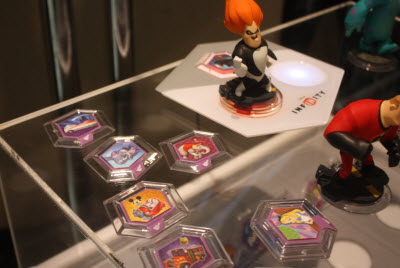 GamesBeat: How soon are some of those other playsets coming?
GamesBeat: How soon are some of those other playsets coming?
Blackburn: At launch, we’ll have Cars and Lone Ranger. Then there’s another playset we’ll be announcing in the holiday season. That would be six altogether, plus the Toy Box. Then there’s a bunch of individual characters and those kinds of things that we’ll roll out as well.
GamesBeat: Do you think of the playsets as expansion packs, sort of?
Blackburn: I think of them as games. When we’re going through and creating them, everything has a common core for the way all the biped characters move, but we have so many other gameplay mechanics in there. It’s crazy. We have never had anything that came anywhere close to this in terms of scale. We have rowboats and pirate ships and jet packs, all sorts of guns, melee combat, mounts, you can fly — all that stuff to take into account — and then you can edit your whole world while you’re playing. That’s one of the key things about it. Within the Toy Box mode, if you get a chance to look at it, that could be an entire game in and of itself.
Talking about an expansion pack, I think maybe the users could perceive it that way. The way I look at this, though, if I’m a fan of a particular Disney property that comes out — say we’ve got a movie next summer — and I want to buy a game for that, I’m incorporating it into my Infinity game. But I’m probably going to play that entire thing as a game right then and there. “Expansion pack” makes it seems like a little add-on. A playset is a brand-new game even though it does interface with everything else.
GamesBeat: Did you have any way to test the waters with this, to see whether consumers would go for it?
Blackburn: We obviously do a lot of market testing and that sort of thing. Some of the biggest consumer tests were actually our own kids and some key executives’ kids. The Toy Box mode in Toy Story 3 was critically acclaimed, but what we all saw was that it was the first time our wives would play with our kids. When our sons and daughters played together, it worked. Some of the key stakeholders in the company, the key creative guys, their kids played it too. We felt like Toy Story 3 was, from a gameplay standpoint, a trial balloon out there. We felt like we’d found something and that we wanted to push that even further. As far as the toy component, it was obvious once we saw the success of Skylanders that this is a way people want to interact and get more content.
GamesBeat: After the launch, do you look at this as a kind of service platform?
Blackburn: Yes, we do. It depends on which platform you’re talking about. There are more service elements on some compared to others. Number one, we do feel like we’re launching a community, particularly with all the user-generated content and all the curation of those things. We’re definitely starting a service there. We’re also debating whether we want to put out more content that we create on our own into that platform.
We have a couple of different logistical issues there — the Wii is a bit more hampered because it doesn’t have storage – but we’re definitely assuming that with all future versions of Infinity, where we’ll be in more of a digital-distribution environment, that will be easier for us. All the platforms that people are working on will have storage, and there will be more content that can come that way.
GamesBeat: Is there a path that you’re going down that you think is different from where Skylanders appears to be headed? One is that they’re doing a game every year, right? That seems clear so far.
Blackburn: Right. The way we’re thinking about this is that it’s a platform that we can use to capture some of the excitement that Disney has. It’s also a way to go back and, with a reasonable investment, bring out new content for some of our old franchises that wouldn’t necessarily deserve. Like, Aladdin might never be capable of getting its own game right now, but we can bring some content back into it through this. From a year-to-year standpoint, we’re looking at a method where, in the future, content will just come along with the films and those sorts of things. It won’t just be one big dump every year.
GamesBeat: When it comes to the multiplatform approach, on their side, they’ve put their feet into mobile. Disney has all these social-mobile platforms as well. How do you feel about how far you want to spread this?
Blackburn: We’re pretty bullish on mobile right now. We’re definitely supporting that. We have details that will be coming out a bit later in our PR cycle on this. Those games have been in development, and we’re getting ready to show them right now. We want to try to make sure those games are as good as they can be for those platforms and that they can appeal to the gameplay type on those platforms. We don’t think you want to sit down and play a six-hour experience on your phone. We’ve gone through and changed all those mechanics and tried to work them in elegantly with the whole theory of toy collection and how all these other parts fit together. So we’re definitely doing that, and we’ll be launching it soon.
VentureBeat's mission is to be a digital town square for technical decision-makers to gain knowledge about transformative enterprise technology and transact. Learn More
